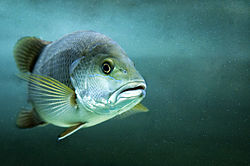- Mangrove red snapper
-
Mangrove red snapper 
A Mangrove Red Snapper from New Ireland, Papua New Guinea Scientific classification Kingdom: Animalia Phylum: Chordata Class: Actinopterygii Order: Perciformes Family: Lutjanidae Genus: Lutjanus Species: L. argentimaculatus Binomial name Lutjanus argentimaculatus
Forsskål, 1775Commonly called Mangrove Jack within Australia, the Mangrove red snapper (Lutjanus argentimaculatus) is an explosive and powerful sport fish that is renowned for its superb eating and fighting qualities.
Coloration of the Mangrove Jack ranges from burnt orange, to copper, to bronze and dark reddish-brown, depending on its age and environment. Younger fish caught in estuarine areas are often darker than older fish taken from offshore reef areas,[1] and exhibit lighter vertical bands down their flanks.
Lutjanus argentimaculatus is found in the Indo-Pacific region from Australia in the south to Japan in the north, and as far west as the eastern coast of Africa.[2] Distribution within Australia is largely centered on the northern half of Australia, spreading from northern New South Wales into northern Western Australia.
As its name implies, the Mangrove Jack is commonly found in mangrove-lined estuarine systems although is known to migrate to offshore reefs in order to spawn. As ambush predators, `Jacks' often dwell around mangrove roots, fallen trees, rock walls, and any other snag areas where smaller prey reside for protection. For fishermen, the telltale sign of a hooked Mangrove Jack is the explosive run for cover once the bait (or lure) is taken. Many fish (and again, lures) are lost once they reach the protection of the snags as a result of their initial burst of speed. As they mature, Mangrove Jacks move into open waters, sometimes hundreds of kilometers from the coast[3] in order to breed. These larger fish are sometimes caught by bottom-fishers with heavy tackle, though they still remain difficult to land due to their speed and proximity to sharp reef bottoms.
The Mangrove Jack is a highly regarded table fish with firm, sweet tasting, white flesh. While often a nuisance species when targeting the infamous Barramundi, many fisherman rate the eating qualities of the Jack higher than its more famous neighbour. In reef areas, Mangrove Jack are sometimes confused with red bass (Lutjanus bohar), a known carrier of Ciguatera toxin. They are however easily distinguishable by the large deep pit in front of the eyes of the red bass.
References
- ^ Queensland Government Fish Note
- ^ Fisheries Global Information System Species Fact Sheet
- ^ Russell, D.J., et al., "Biology, Management and Genetic Stock Structure of Mangrove Jack (Lutjanus argentimaculatus) in Australia," The State of Queensland, Department of Primary Industries and the Fisheries Research Development Corporation, FRDC Project Number 1999/122, 2003.
Categories:- Lutjanidae
- Lessepsian migrants
Wikimedia Foundation. 2010.
